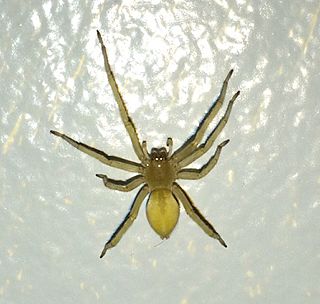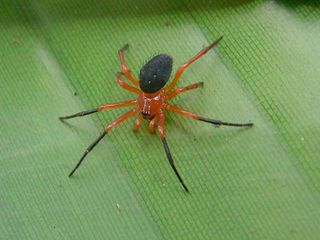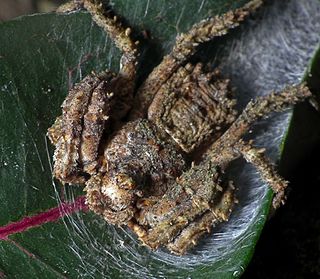
Cheiracanthium inclusum, alternately known as the black-footed yellow sac spider or the American yellow sac spider, was formerly classified as a true sac spider, and then placed in the family Miturgidae, but now belongs to family Cheiracanthiidae. It is a rather small pale yellow species that is indigenous to the Americas and can be found living in the foliage of forests and gardens but also can inhabit human homes. Despite common beliefs of necrosis, Cheiracanthium bites cause only localized swelling. C. inclusum is closely related to Cheiracanthium mildei, an introduced species native to Europe which is similar in appearance and natural history and can also be found in North American homes.

Austracantha is a genus of spider with a single species, Austracantha minax, commonly known as the jewel spider or the Christmas spider. It is a member of the family Araneidae and is endemic to Australia. They are relatively small spiders, reaching a maximum total body length of only around 12 mm (0.47 in) for females, and 5 mm (0.20 in) for males. Their abdomen has six distinctive projections ("spines") that makes them easy to identify. They are predominantly a shiny black, with variable white, yellow, and orange patterns. Melanistic forms also occur during autumn. They are facultatively gregarious, and can be found in large aggregations of overlapping orb webs. They feed on small flying insects that get entangled in their webs. They are harmless to humans, though the webs can be a nuisance for bushwalkers. They are most abundant during the summer months.

Celaenia excavata, the bird dropping spider of Australia and New Zealand, derives its name from mimicking bird droppings to avoid predators, mainly birds. However, there are other species of spider that resemble bird droppings, for example species of Mastophora.

The European fire-bellied toad is a fire-bellied toad native to mainland Europe. Other common names used for the European fire-bellied toad include ringing frog, fiery toad, fire frog, and firebelly toad. It is a popular pet due to its bright colored belly.

Deinopis subrufa is a species of net-casting spiders. It occurs in Australia and in New Zealand. It is a nocturnal hunter, having excellent eyesight, and hunts using a silken net to capture its prey. They feed on a variety of insects – ants, beetles, crickets and other spiders. They can vary in color from fawn to pinkish brown or chocolate brown. Females are about 25 mm in body length, males about 22 mm. They are not dangerous to humans.

Plebs bradleyi, synonym Araneus bradleyi, is a spider in the orb-weaver family Araneidae. Known as the enamelled spider, it is a common Australian spider. It occurs in Tasmania, New South Wales, Queensland and Victoria.

Arachnura higginsi, known as the tailed spider or scorpion tailed spider and the scorpion orb weaver, is a common Australian spider belonging to the family Araneidae. It occurs in many parts of Australia.

Sidymella rubrosignata is a species of crab spiders found in Australia. It is a common spider, often seen on Dianella plants.

Arkys lancearius, the triangular spider, is a common Australian spider belonging to the family Arkyidae. It is an ambush hunter, commonly found resting on leaves and ferns or hanging from just a few threads of silk. The front two pairs of legs are large, suited for grabbing small insects, while the rear pairs of legs are much smaller.

Ariamnes colubrinus, known as the whip spider, is a common Australian spider belonging to the family Theridiidae. It is found in Victoria, New South Wales and Queensland.

Cyrtophora exanthematica are tent spiders common in tropical Asia and Australia. They are commonly known as double-tailed tent spiders because of the pair of blunt projections at the end of their abdomens. They are harmless to humans.

Palystes is a genus of huntsman spiders, commonly called rain spiders or lizard-eating spiders, occurring in Africa, India, Australia, and the Pacific. The most common and widespread species is P. superciliosus, found in South Africa, home to 12 species in the genus. The name Palystes is derived from either the Latin palaestes or the Greek palaistes, meaning "wrestler". The genus was first described by Ludwig Carl Christian Koch in 1875.

Nicodamus peregrinus, known as the red and black spider, is a common spider found in eastern and southern Australia. Unlike with the redback spider, the bright red coloration does not appear to warn of significant danger to humans. Food is a variety of small insects. They have been recorded in Queensland, New South Wales, Victoria, Tasmania and South Australia.
Philoponella congregabilis, sometimes referred to as the little humped spider, is an Australian species of communal spider that, like other species of Uloboridae, does not use venom. Instead it wraps its prey in spider silk to crush it to death. The spider then goes on to regurgitate digestive fluid into the shroud, then consuming the pre-digested liquid. The specific name congregabilis translates to "community dwellers". The generic name Philoponella alludes to their industrious nature, "loving labour".

Thomisus spectabilis, also known as the white crab spider or Australian crab spider, is a small spider found in Australia and far east Asia.

Stephanopis altifrons is a crab spider found in Australia. A cryptic species often hidden on bark of a tree. The body length of the female is up to 10 mm, the male 6 mm. The colour is usually brown, or shades of grey, sometimes black. The egg sac is 7.5 mm in diameter. Often placed in a crevice in tree bark; irregular in shape and camouflaged with debris. Eggs are off white in colour, 25 to 30 in number. The female rests with the eggs. The food of this spider is appears to be other spiders. Recorded prey include spiders in the families Salticidae and Hersiliidae.

Cyrtophora hirta is a species of tent spider found in the Australia. The southern range of distribution is near Sydney, though there are New Guinea and Tasmanian records on the Atlas of Living Australia. Ludwig Koch described the species in 1872 from specimens from Bowen, Queensland.

Australomisidia cruentata, one of the crab spiders, is a small spider found in Australia. The body length of the female is up to 5 mm, the male 3 mm. An ambush predator, often seen on flowers in the Pultenaea group of egg and bacon plants, belonging to the pea family. The egg sac is also laid on the flowers. Petals being fastened with silk in a chamber. The spider stays with the eggs, probably still hunting from the entrance of the retreat, with the egg sac nearby. Prey is small flying insects. The genus Australomisidia was created in 2014, the word being a combination of Australia and Thomisidae, the crab spiders.

Venatrix furcillata, one of the wolf spiders, is a mid sized spider found in eastern Australia. The body length of the female is up to 13 mm, the male 9 mm. The abdomen has distinctive tapering markings. Sometimes noted in suburban gardens and lawns. It lives in a simple burrow, but may be seen migrating in large numbers to a communal web, an unusual feature for wolf spiders. The grey coloured spherical egg sac is around 6 mm in diameter, carried by the female. Eggs are 45 to 60 in number, 0.8 mm in diameter. Prey is ground dwelling insects. The spider has been identified as occurring in Queensland, New South Wales, and Victoria.

Arbanitis robertsi is a species of tube spider in the family Idiopidae found in and near rainforests in New South Wales and Queensland, Australia. A mid to large sized spider which builds a tube of web that extends from the burrow. The tube is attached to rocks, tree ferns or the base of trees. Thousands of these tubes were recorded by Sid Jackson in November 1922 at the south eastern end of Wallis Lake. "Up to three feet long, and half an inch wide". Situated on damp ground, close to freshwater streams.



















